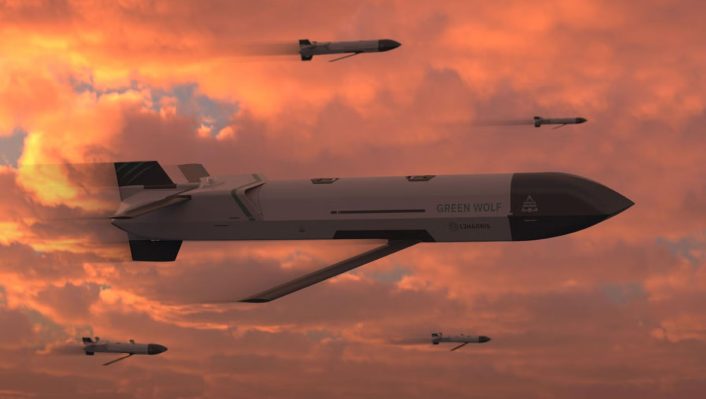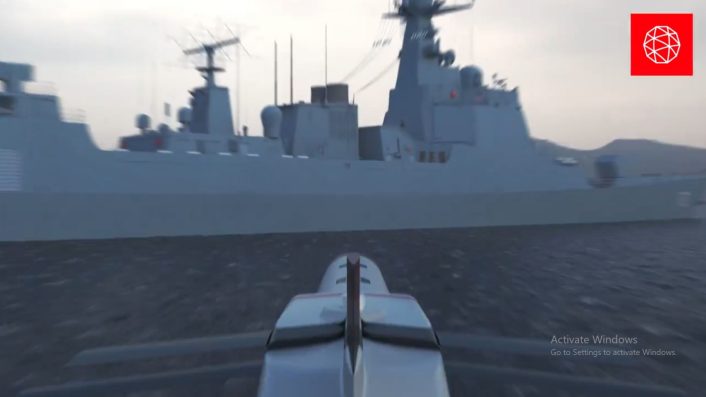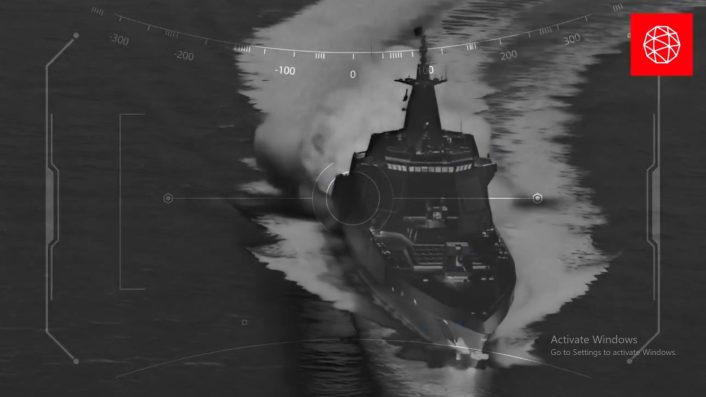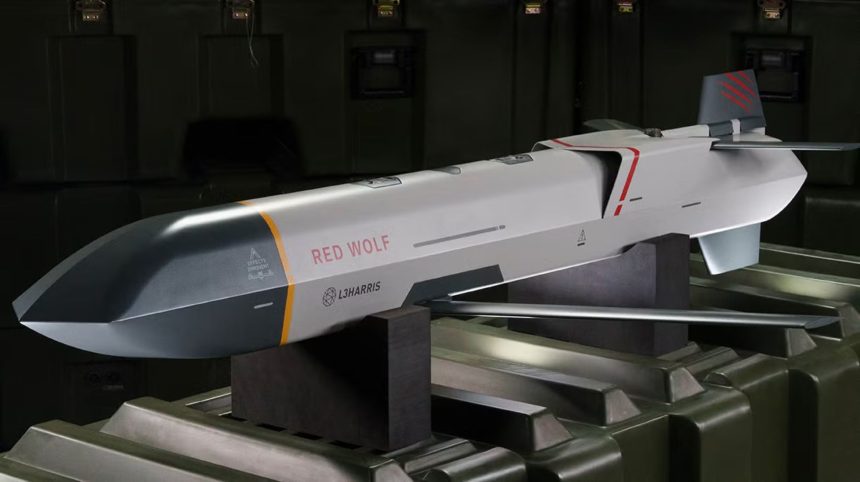The missiles, which can provide both kinetic and non-kinetic effects, have been tested over 40 times since 2020 from both rotary and fixed wing platforms.
L3Harris has shed more light on its family of launched effects vehicles, officially identifying them as Red Wolf and Green Wolf, meant for kinetic and non-kinetic roles, respectively. In May 2025, the U.S. Marine Corps revealed Red Wolf as the designation of the mystery missile that NAVAIR (Naval Air Systems Command) tested in November 2024.
Two of the missiles, with a vastly different design than the ones unveiled now by L3Harris, are seen on the outboard wing stations of an AH-1Z Viper attack helicopter in what was described as a Long-Range Precision Fire (LRPF) missile test at Yuma Proving Ground, Arizona. The test was part of the service’s Long-Range Attack Missile (LRAM) project within the broader Precision Attack Strike Missile (PASM) Program of Record.
NAVAIR further said the missile was a “cost-effective” weapon for “maritime and land-based targets.” This would be in line with multiple recent programs which seek the procurement of new low cost weapons to be used by multiple platforms.
The missile seen on the Viper in the November 2024 test could not be seen clearly. However, an image believed to show the actual Red Wolf during the U.S. Army’s Project Convergence Capstone 4 multinational exercise in 2024 and the new image released by L3Harris show significant design differences. It is unclear if there are different baseline designs of the Red Wolf and Green Wolf or if that is the result of the design’s evolution.
The wait is over.
Introducing Red Wolf ᵀᴹ and Green Wolf ᵀᴹ, the first vehicles in our expanding pack of launched effects systems. pic.twitter.com/d4oG7fgeE4
— L3Harris (@L3HarrisTech) July 17, 2025
Design configuration
The first two sightings of the weapon showed the same cruciform tail, but have differing air intake placements. The Red Wolf on the Viper – assuming it is a pre-production model before L3Harris released its actual image now – has a large ventral inlet, protruding from the missile’s body. The purported Red Wolf at the Capstone 4 exercise has a small top-mounted inlet towards the rear, almost flush with the missile’s body.
#ICYMI Long Range Precision Fires (LRPF) was successfully executed at Yuma Proving Grounds in Yuma, AZ, Nov 2024. The event was completed with an AH-1Z Viper launching a single weapon by way of a wireless application. #MakeAnImpact #MarineCorpsAviation https://t.co/jpvGJEDwjR pic.twitter.com/RBksnVLsup
— NAVAIR (@NAVAIRNews) February 14, 2025
However, the Red Wolf revealed by L3Harris now diverges considerably, sporting a conventional tail, with a bottom vertical stabilizer. The rear air intakes are now moved to the sides, with the overall body being highly faceted while the nose is almost shovel-like.
I think I saw a picture of Red Wolf at PC-C4 https://t.co/Jd14a2p37g pic.twitter.com/ccv42tdffo
— 笑脸男人 (@lfx160219) May 2, 2025
The wings are low-mounted and pop out after release. A product catalogue from the company shows the Green Wolf with the exact same design, but meant for “non-kinetic EW (Electronic Warfare), EA (Electronic Attack), DLIR (Detect Identify Locate and Report)” roles. The Red Wolf meanwhile is a kinetic strike weapon.

L3Harris’ concept video shows the Red Wolf striking a PLA Navy Type 52D destroyer, consistent with previous Marine Corps drills where an AGM-179 JAGM (Joint Air to Ground Missile) was fired from AH-1Z Vipers on a maritime target in the Indo-Pacific. We assessed back then that the goal might be to conduct light disabling strikes on the sensor masts of the warships to blind them temporarily to allow larger follow-on strikes by AGM-158C LRASM (Long-Range Anti-Ship Missile).
The Corps previously has expressed a need to be able to reach ranges of 170 miles (278 kilometers). Extended range variants of the Hellfire, like the AGM-114R-4, or the JAGM’s ‘MR’ version have maximum ranges of 21 miles and 10 miles respectively, which are drastically shorter than what the Corps desires.
Additionally, as is the standard with today’s weapons design mantras, the missiles are scalable and modular, meeting the DoD’s need for low-cost mass munitions. However, this has the added advantage that the weapons can be quickly and easily upgraded when new technology is available.
Pasifikte eldeki esnekliği arttıracak tüm kabiliyetler önemli olacak!US Marines Bell AH-1Z Viper ile Pasifikte ‘Mock Vessel’ hedefler üzerinde AGM-179 Joint Air-to-Ground(JAGM) füzelerinin testlerini gerçekleştiriyor.2022de tam üretim kapasitesiyle bantlardan çıkmaya başlayan👇🏻 pic.twitter.com/cQ5PyRJwyU
— Megatron (@decepticon46) October 17, 2024
Capabilities
L3Harris, while stating that it has “matured” the design with over 40 test flights and demonstrations “through programs with multiple DoD customers,” puts the Red Wolf’s and Green Wolf’s endurance at over 200 nautical miles at low altitudes, with an endurance of 60 minutes and above.
The large testing campaign also explains the vast divergence between the design seen in the November 2024 test and the current iterations. The configuration, especially the elimination of the large protruding ventral air intake, suggests that the missile has been optimized for a certain degree of stealth.
The test campaign has been underway since 2020, with the vehicles having been successfully launched from crewed, uncrewed fixed-wing, rotorcraft and ground-based platforms. They also are capable of rocket-assisted launches from ground or sea platforms.

The air breathing engine is optimized for high-altitude, high-speed flight profiles, being able to start at 40,000 feet “without the use of pyrotechnics.” Its modular nose bay allows up to 300 cubic inches of volume for kinetic and non-kinetic payloads.
The company shows three illustrations of Red and Green Wolves being launched by rotary wing platforms in ‘ground’, ‘expeditionary’ and ‘maritime’ missions, acting in concert to overwhelm and strike radar emitting warships and ground stations. UAVs and satellites are part of the networking and target engagement chains, while USVs and ground vehicles are also shown to be able to launch the missiles.

L3Harris said in a statement: “Both vehicles are flexible, modular and feature advanced software for in-flight collaboration and re-targeting. They also support swarming capability of autonomous aircraft.” L3Harris’ President of Space and Airborne Systems, Ed Zoiss, said their “launched effects ‘wolf pack’ provides […] significant advantage in closing long-range kill chains, defeating adversarial threats in challenging environments and protecting assets.”









